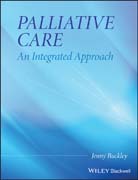
This evidence based text brings together the theory and practice of palliative care. It examines at all aspects of palliative care i.e. psycho social, spiritual and physical in a highly practical way. The evidence base for cancer care has been developed within the Hospice Movement over the past 50 years and, in the main, it transfers across to patients dying of diseases other than cancer. The book addresses the palliative needs of any patient with any disease in any care setting, which gives it a generic approach. This is in line with current government directives. Contributions to care and treatment are considered in a multidisciplinary and complementary way. INDICE: Foreword. Contributors' biographies. Acknowledgements. Dedications. 1 Historical and cultural perspectives on the evolution of palliative care. Key points. Introduction. Death in society. Dame Cicely Saunders and the origins of contemporary palliative care. An international perspective. Definitions.End-of-life care national programme. Culture. Service user involvement. Conclusion. Main implications for practice. Suggested further reading. 2 Facing progressive disease and death. Key points. Psychosocial care. Partnership - maintaining the balance. Approaches to care. Giving the bad news. Denial/avoidance.Anger. Anxiety. Depression. Social pain. Conclusion. Main implications for practice. Suggested further reading. 3 Communication skills. Key points. The impact of good communication. The impetus to teach communication skills. Facilitative styles. What Howard taught me about nursing dying people. Helpful strategies. Communicating with people with dementia. Conclusion. Main implications for practice. Suggested further reading. 4 Self-awareness and self-care. Key points. Saving a life versus stealing a death. Facing death. Making space for decision-making. Self-awareness. How much did Nicky impact on my life?Self-care. Main implications for practice. Suggested further reading. 5 The sick role andpartnership working. Key points. Introduction. Partnership care - what does it mean?The sick role. Face-to-face partnership: attention to information giving. Written information. Decision aids. Special needs. Conclusion. Main implications for practice. Suggested further reading. 6 Hope and spirituality. Key points. Introduction. Hope research. Spirituality. Religious practices concernedwith death. Conclusion. Main implications for practice. Suggested further reading. 7 Finding resilience together. Key points. Resilience in health care. Patient groups. Psychoneuroimmunology. The expert patient. Conclusion. Main implications for practice. Suggested further reading. 8 Living with dying. Key points. Introduction. Social death. Vulnerable groups. Informational needs. Beingheard and feeling supported. Companionship. Intimacy and caring. Health needs. Difficult thoughts and letting go. Conclusion. Main implications for practice. Suggested further reading. 9 Bereavement. Key points. Defi nitions. Untimely deaths. Bereavement and health. Grief theorists. Mourning practices in different cultures. Bereaved children. Old age. Bereavement and dementia. Solitary grief. Bereavement services. Conclusion. Main implications for practice. Suggested further reading. 10 Pain and other major symptoms: an integrated approach. Key points. Pain theories. Psychological approaches. Physical approaches. Complementary therapies. Creative therapies. Conclusion. Main implications for practice. Suggested further reading. 11 The history of the use of strong opioids for cancer pain. Key points. Studies and narratives. WHO analgesia ladder. Side effects. Alternative routes for administration of strong opioids. Conclusion. Main implications for practice. Suggested further reading. 12 Concordance and advance care planning. Key points. Patient-centred care: concordance. Advance care planning. The Mental Capacity Act 2005. Main implications for practice. Suggested further reading. 13 Eleven prevalent symptoms... ETC.
- ISBN: 978-0-470-05885-5
- Editorial: Wiley-Blackwell
- Encuadernacion: Rústica
- Páginas: 331
- Fecha Publicación: 01/11/2008
- Nº Volúmenes: 1
- Idioma: Inglés
